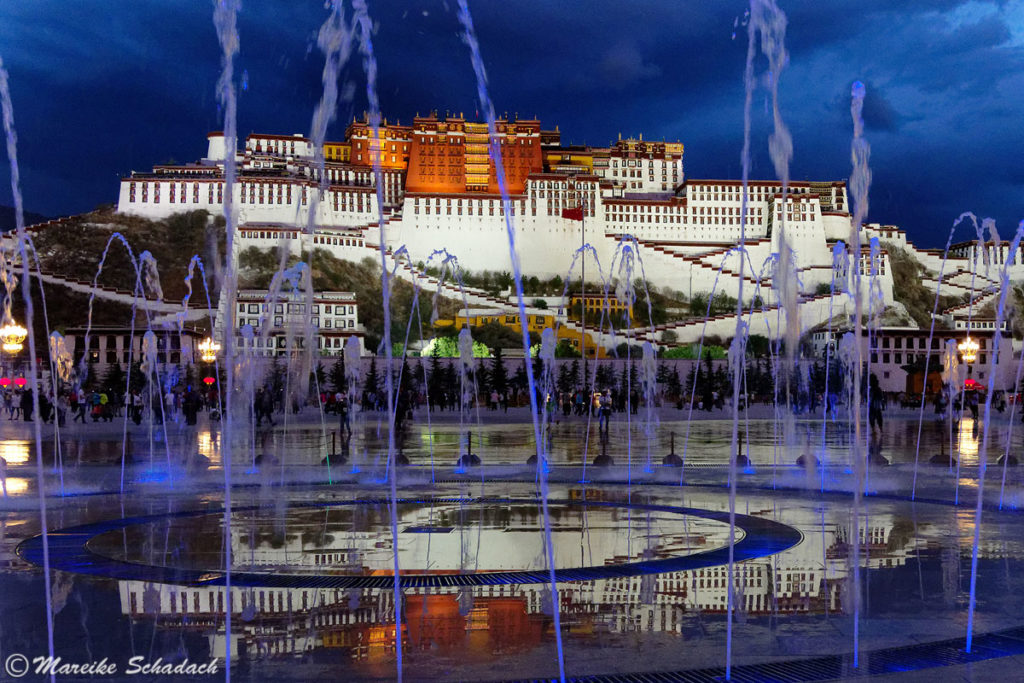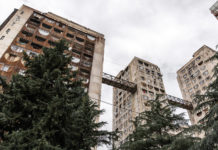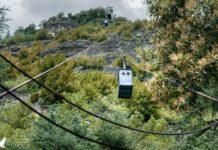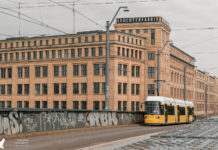China, Tibet. An old woman walks in front of me. Her hair is grey, her back is bent. She is dressed in a traditional costume. She walks the Kora around the Jokhang Temple, step by step. With her right hand she pushes her wheelchair. With her left hand she turns her prayer wheel. Slowly I walk past her and hear her quietly recite a mantra. A short moment, actually quite unspectacular. But a moment that touched me deeply and will probably always remain in my memory. We joined the pilgrims and circumnavigated the Jokhang Temple three times clockwise. In my following article, learn more about the Barkhor pilgrimage path and the Jokhang Temple in Lhasa, what I liked most and what tips I can give you for your visit.
Non-solicited, unpaid advertising. This article contains affiliate links*, marked with an asterisk.
Content
Barkhor - Pilgrim Path in old Lhasa
Ritual Prostrations
Evening at the Barkhor
Barkhor Square in front of Jokhang Temple
Photo Shooting in Tibetan Costumes
Jokhang Temple - holiest Temple in Tibet
Inside the Jokhang Temple
Barkhor - Pilgrim Path in old Lhasa
The Barkhor is the lifeline of old Lhasa. It is both a pilgrimage route and a shopping mile. At 800 meters it leads around the holy Jogkang Temple. Pilgrims circle the temple three times clockwise. In the cooler evening hours it resembles an ant trail. Nowhere else you come so close to old Lhasa as here. The atmosphere of the Barkhor is filled with a magic that I have experienced in few places so far. Its variety and liveliness, its people and its stories have fascinated me.

Shortly before reaching the bar gate we are stopped by a security check. Our backpacks are x-rayed, our passports and travel permit are checked. We are allowed to continue. Shortly afterwards we are caught by a stream of people. Monks and tourists, young and old, with or without a prayer drum in their hands. They all run past us clockwise. Especially believers walk the Kora, however, in a sequence of prostrations.
Tip 1: Take your passport and the travel permit with you. You will be checked at the entrances. Sometimes you are asked for the name of your hotel. The easiest way is to show the hotel a business card.

Tip 2: Take your time at Barkhor, watch and drift. This is the best way to capture the special atmosphere. Be open for everything you see and discover the special in the everyday moments right in front of your eyes.
Ritual Prostrations
The sequence of the prostrations is repeated with impressive precision: first the hands are folded, led over the head, then in front of the forehead and the throat. Now the actual bowing follows. The hands are supported on the floor. Both knees are padded with thick cushions. The hands are now pushed forward until the whole body touches the floor. For this, thick gloves or wooden plates are used. With these the hands glide as on small sleds over the asphalt. Then the forehead touches the ground and the hands are folded in front of the head. Many put down a small object at the foremost point reached, up to which they then run forward to begin a new prostration.
Tip 3: Always walk clockwise along the Barkhor! Only the believers of the old Bon religion go counterclockwise.
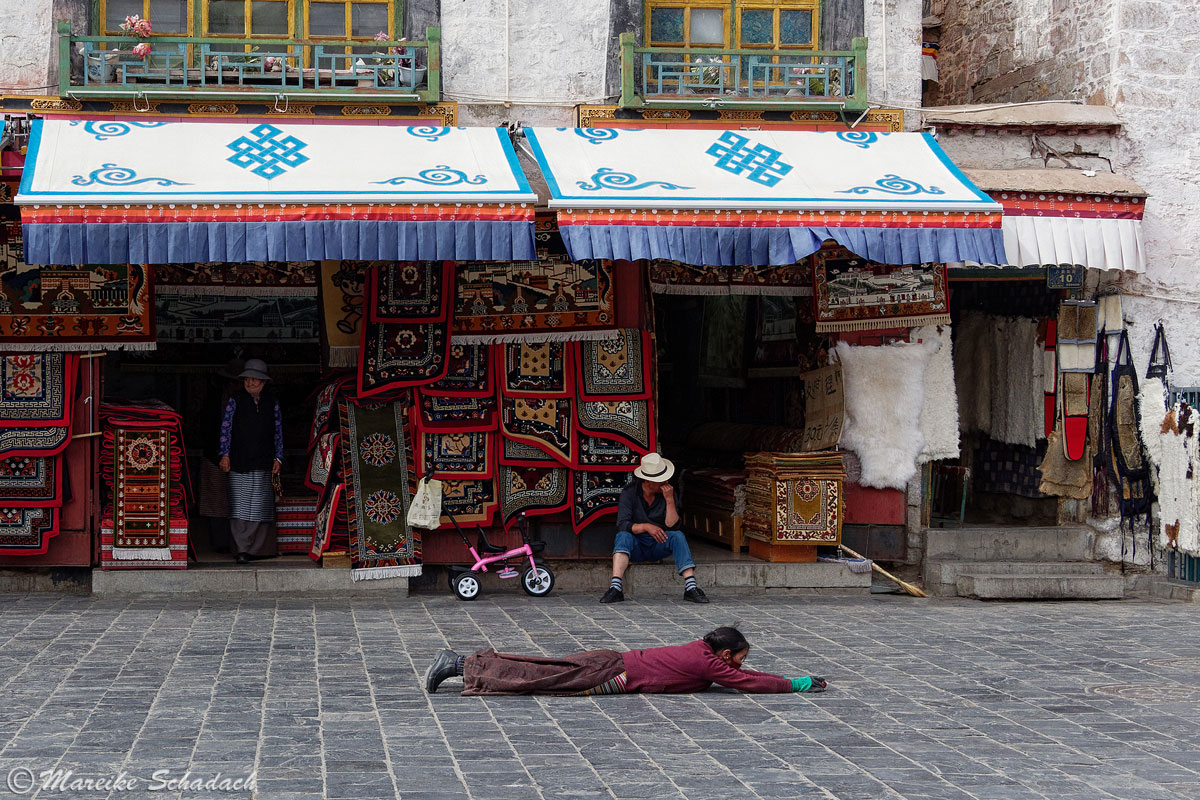
Tip 4: Got hungry? Around the Barkhor and also in the side streets there are many restaurants with delicious Tibetan food and a view from the roof terrace. Try the Momos, which are dumplings with different fillings.
Evening at the Barkhor
Especially in the evening hours you can experience a lively old Lhasa at Barkhor. It will be even more crowded than during the day. Even more pilgrims are on their way, circling the temple with a sequence of prostrations. Among them are even mothers with small children. Many young people meet and circle the temple together. During breaks, they sit on the floor and check their messages in the smartphone. Two older women walk in front of us. Slow and limping, their posture testifies to a life of hard physical work. I would love to hear their stories. Or what is the story of the two monks sitting on a bench behind the shields of two policemen drinking coffee next door? What is the story of the Han Chinese woman, dressed in a Tibetan costume, posing in front of the temple and having herself photographed?
There are so many impressions, emotions and questions that pelt into me. The dark sky and the lighting in the streets seem to make the atmosphere at Barkhor even more sacred than it already is during the day. Especially impressive is the large Barkhor Square in front of the Jokhang Temple. We have collected so many impressions here and it is hard to put them into words. The Barkhor and the Jokhang Temple have a magical attraction.

Tip 6: Every Tibetan should have made a pilgrimage to Jokhang Temple once in his life. The three times rounding of the temple along the Barkor and the ritual prostration in front of the entrance should protect against a bad rebirth. Especially many Tibetans visit Lhasa for the Saga-Dawa festival. They pray in front of the Jokhang temple and walk the Kora. During this time you can experience the diversity of Tibetan culture particularly intensively.
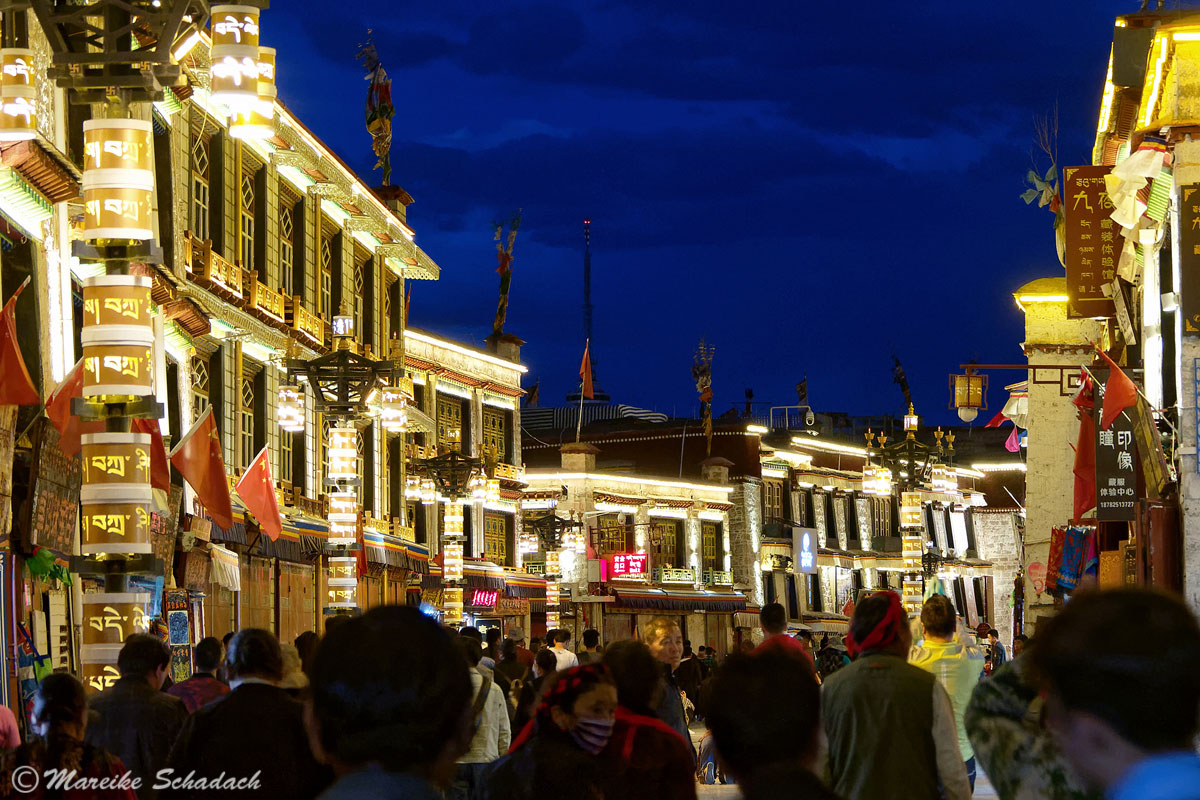
Barkhor Square in front of Jokhang Temple
The atmosphere in front of the Jokhang Temple is moving. I remember the atmosphere in front of the Wailing Wall in Jerusalem at Christmas 2016, where people pray around the clock. In front of the entrance to the temple the faithful are doing prostrations. Many of them have brought mattresses especially for this purpose. Some of them start their circumnavigations from here, put on knee pads, aprons and gloves.
Tip 7: At dusk, when the big lanterns light up, it is particularly beautiful here and the light is great for taking pictures.
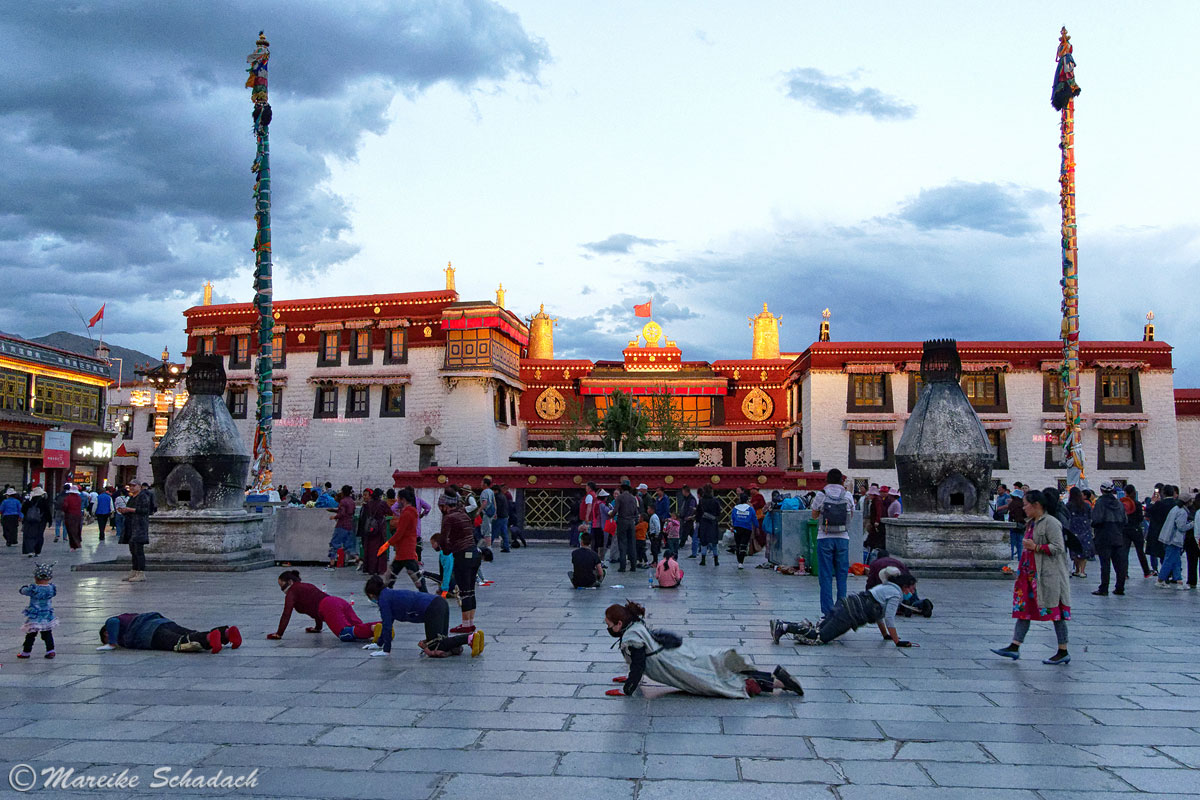
Between the believers, however, police can be seen again and again. Right and left at Barkhor Square there are policemen and emergency vehicles. After unrest in the Tibetan capital Lhasa, which began in March 2008, security checks were tightened here. Since 2009 there have been desperate self-immolations in protest. With their act of desperation they demanded freedom for Tibet and the return of His Holiness the Dalai Lama. In May 2012, two Tibetans set themselves on fire at Barkhor Square in Lhasa. One of them survived. In response, security measures in Lhasa were tightened. The streets in Lhasa were full of police and paramilitary forces. Chinese security forces immediately removed all traces of the incident.
Tip 8: A really nice Tibetan style hotel is the House of Shambala, close to the Barkhor. There is also a good selection of super delicious food here.
Photo Shooting in Tibetan Costumes
Souvenir shops, precious stones, clothes for monks, Tangkas and costumes. You can get everything in the shops at Barkhor. Costumes? You have read correctly. Alone along the Barkhor there are sixteen shops lending Tibetan costumes for photo shoots. And it's almost a familiar sight at the Barkhor: Chinese women can be photographed in traditional Tibetan costumes. The hair is elaborately styled and decorated with jewellery. In the hand they often hold a prayer wheel. An old woman with a weathered face walks the Kora around the holy Jogkang temple. While she turns her prayer wheel in her hand she mumbles incessantly "om mani padne hum". The Barkor lives from his contrasts. Worlds collide here. I would like to know what the old woman thinks about the Chinese woman in a Tibetan costume, in whose hand the prayer wheel becomes a photo accessory.
Is the costume just a funny tourist gag, in which the model and the photographer think nothing else of? Or is it a new way in which China hoists its national flag in Tibet and appropriates Tibetan culture? Do these photos suggest that Tibetan culture has always belonged to China? Or does the young generation have a serious interest in Tibetan culture? Unfortunately, my questions remained unanswered.
Tip 9: The costumes are damn beautiful to look at. Both in real, and on the advertising photos with which the costume rental companies recruit customers. Take some time and have a look at them. Maybe you can take some pictures yourself.
Do you also like to take photos yourself? Then you will certainly like my article with photo tips for the Potala Palace. bestimmt gefallen.
Long tested and much loved: my three companions on photo tours: the lightweight carbon tripod CT-5C I from Rollei*, the cleaning kit from Rollei*and my indestructible camera backpack, the camera backpack, the Flipside from Lowepro*.
Jokhang Temple - holiest Temple in Tibet
The Jokhang Temple was built in the 7th century by King Songtsen Gampo and is therefore the oldest temple in Lhasa. It is also the holiest temple in Tibet and the center of Tibetan Buddhism. Its present appearance with the entrance and the golden roofs, however, the temple received only under the V. Dalai Lama in the 17th century.

In 1959, freedom fighters temporarily entrenched themselves in the Jokhang Temple, which was then fired upon. All religious ceremonies were forbidden during the Cultural Revolution between 1959 and 1972. During this time the temple was used as a cattle stable and therefore remained largely intact. In the upper rooms were the rooms of the Tibetan government.
Today the pilgrims pray at any time of the day in front of the temple. In the stone stoves in front of the main entrance smoke offerings from herbs are offered. The destroyed statues have been replaced in the meantime and since 1994 the Jokhang Temple even belongs to the world cultural heritage of UNESCO.

Inside the Jokhang Temple
After you have passed the main entrance, you will come to a forecourt, which in turn leads to the square in front of the actual temple. In the entrance of the temple, the temple guards are guarding every temple and public building in Buddhism. In the middle of the temple are mighty statues, in front of which are the prayer benches of the monks. Along the outer walls there are many small chapels. A special feature of the Jokhang temple is a huge three-dimensional mandala. Opposite the entrance, at the other end of the room, you can see the Buddha figure that Princess Wengcheng gave to the king as a wedding present.
Tip 10: No photos are allowed inside the temple. Photographs may only be taken in the outdoor areas and on the roof. After you have left the inner area, you can end your temple visit on the roof with a cool drink.
Book Recommendations for Tibet
You want to know where the journey goes? Then I can recommend these books* about Tibet.
You can order these books at Amazon with a click on the pictures. If you buy a product via one of these affiliate links, I get a small commission and you help me to keep filling Fernweh-Motive with interesting articles. The product will not be more expensive for you.
Have you ever been to Lhasa yourself and walked along the Barkhor? How did you like it? Do you have any questions about my article or suggestions? If so, please write me a comment!
Do you want to know when there are new articles on my blog? Then follow me on Facebook, Pinterest or Instagram. I would also be very happy if you share my article with your friends.







